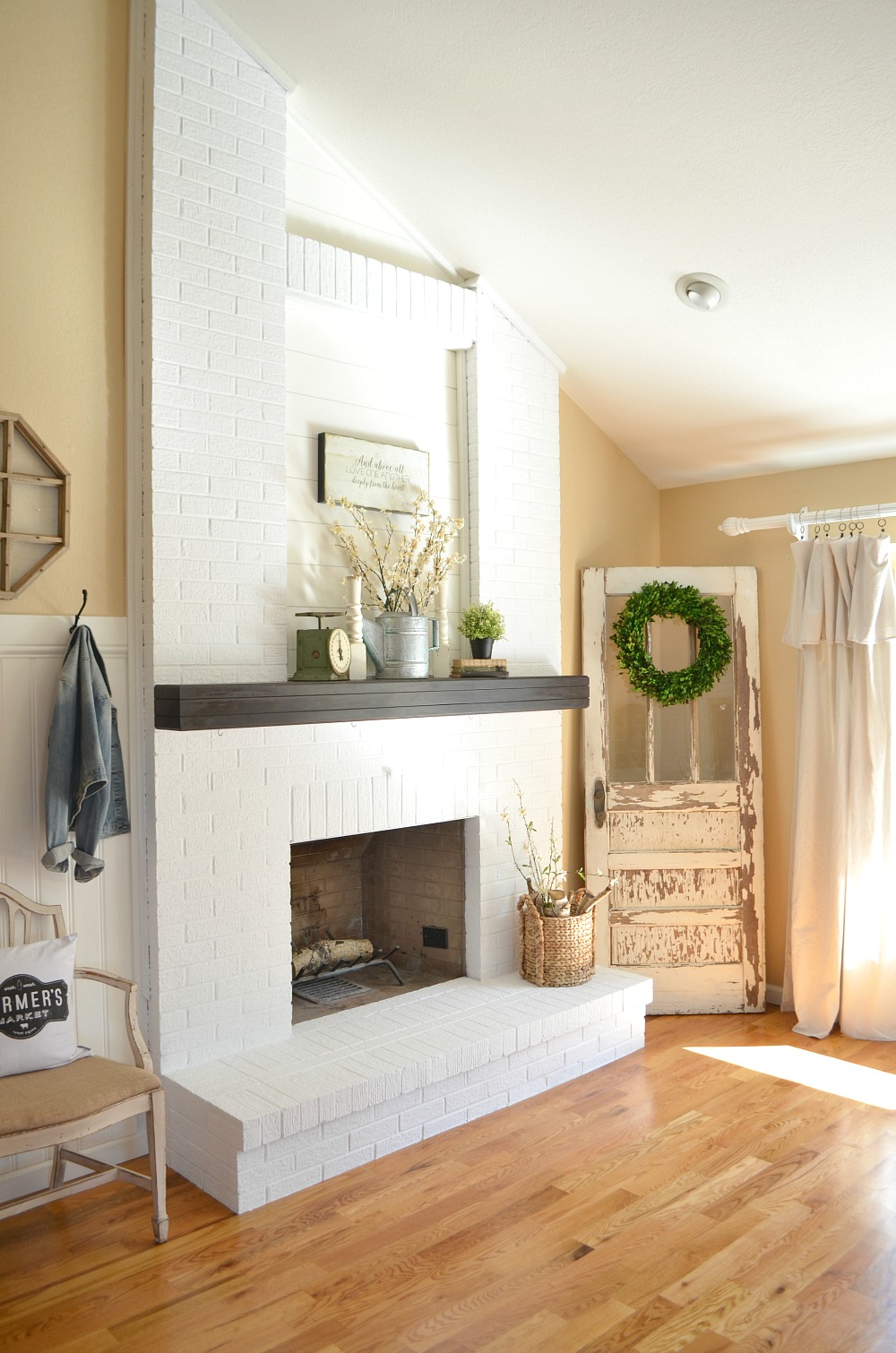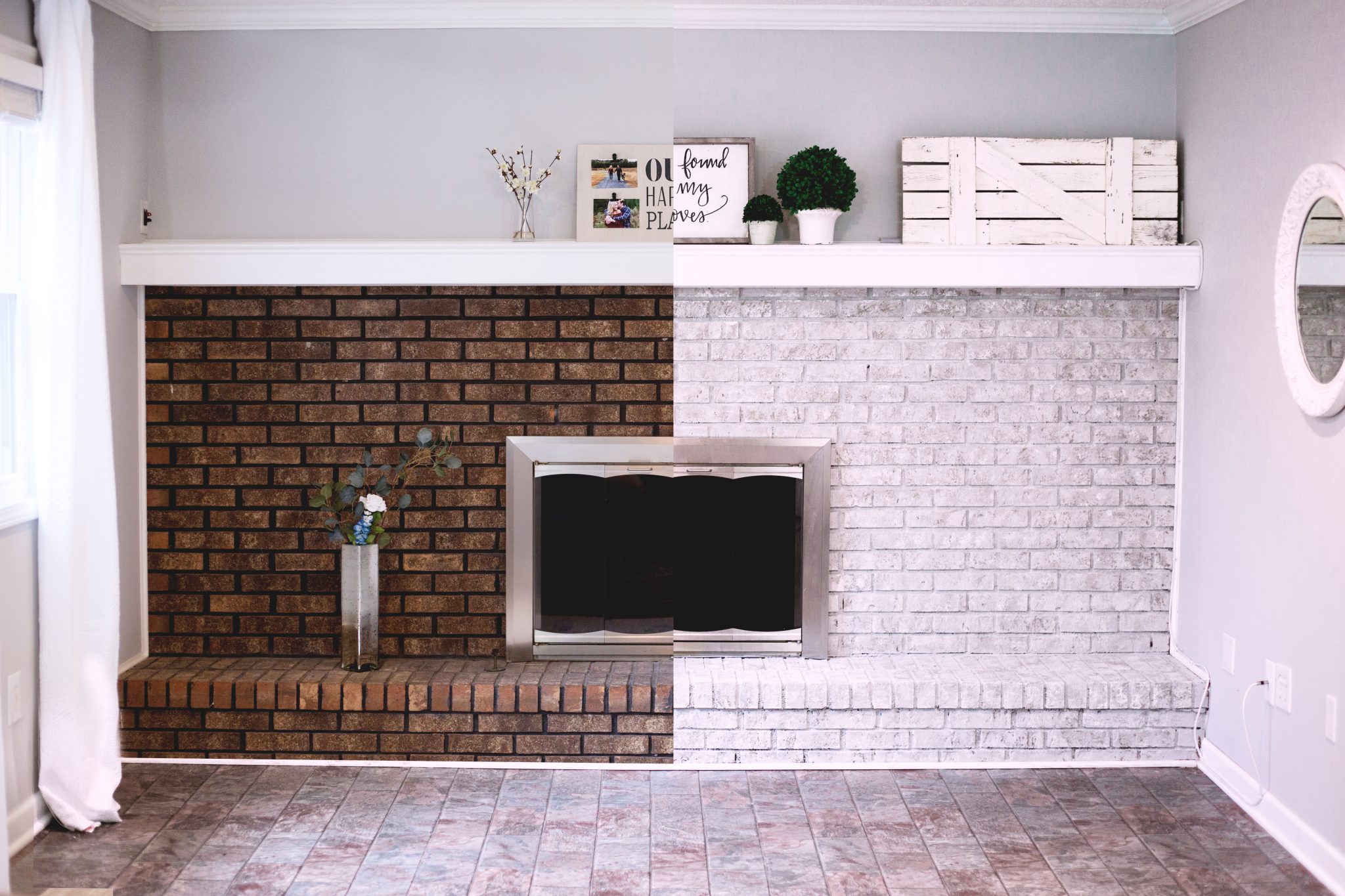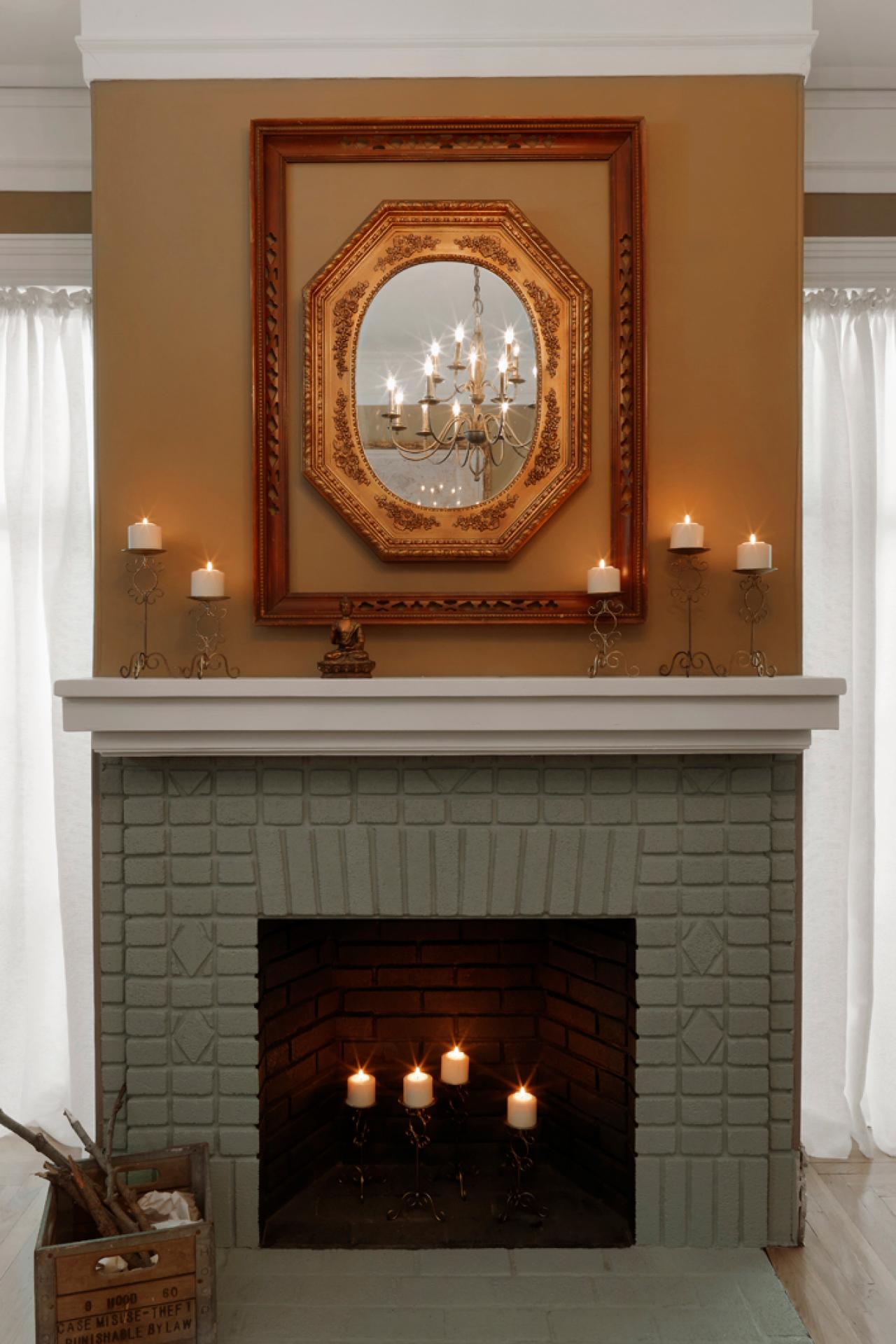Painting a brick fireplace can transform a room, giving it a fresh and modern look while preserving the rustic charm of the brick. However, painting a brick fireplace requires careful preparation and the right techniques to ensure a durable and attractive finish. Here are detailed tips for painting a brick fireplace, covering everything from preparation to choosing the right paint, techniques for application, and post-painting care.

Preparing the Brick Surface
Proper preparation of the brick surface is crucial for achieving a smooth, long-lasting finish. The preparation process involves cleaning, repairing, and priming the brick.
Cleaning the Brick: Start by thoroughly cleaning the brick to remove any dirt, soot, or grime. Use a stiff-bristle brush and a mixture of warm water and mild detergent. Scrub the brick vigorously to ensure all debris is removed. For stubborn stains, consider using a TSP (trisodium phosphate) solution, but be sure to follow the safety instructions on the product label.
Removing Efflorescence: Efflorescence, a white powdery substance that can form on brick surfaces, needs to be removed before painting. This is typically caused by moisture drawing salts to the surface. Use a stiff-bristle brush or a mixture of vinegar and water to scrub the efflorescence away. Rinse thoroughly with clean water.
Repairing Cracks and Gaps: Inspect the brick for any cracks or gaps that need to be filled. Use a high-quality acrylic caulk to fill small cracks and gaps. For larger cracks or damaged areas, use a mortar repair compound. Allow the repairs to dry completely according to the product instructions before proceeding to the next step.

Sanding the Surface: After cleaning and repairing, lightly sand the brick surface to create a smooth and even texture. This will help the primer and paint adhere better. Use medium-grit sandpaper and sand in a circular motion. Be sure to wear a dust mask and safety goggles to protect yourself from brick dust.
Priming the Brick: Priming is essential for ensuring the paint adheres properly and lasts longer. Use a high-quality, oil-based, or latex masonry primer. Apply the primer with a roller or brush, ensuring full coverage of the brick and mortar joints. Allow the primer to dry completely as per the manufacturer’s instructions before applying the paint.
Taping and Protecting Surrounding Areas: Use painter’s tape to protect the areas around the fireplace, such as the walls, mantel, and floor. Lay down drop cloths to catch any drips or splatters. This will ensure a clean and professional-looking finish without accidental paint marks on other surfaces.

Choosing the Right Paint
Selecting the right type of paint is essential for achieving a durable and aesthetically pleasing finish. Consider factors such as paint type, finish, and color when making your choice.
Paint Type: For painting brick, use either latex or oil-based paint. Latex paint is more flexible and less prone to cracking, making it a popular choice. Oil-based paint, while more durable, can be more challenging to work with and has a stronger odor. Both types can be used, but ensure the primer you choose is compatible with the paint type.
Paint Finish: The finish of the paint can significantly impact the look and maintenance of the fireplace. Satin or eggshell finishes are commonly used for brick because they provide a slight sheen that is easy to clean. Avoid high-gloss finishes as they can highlight imperfections in the brick surface.
Color Selection: Choosing the right color for your brick fireplace depends on the overall aesthetic of your room. Neutral colors like white, gray, or beige are timeless and versatile, blending well with various decor styles. Bold colors like black or deep blue can create a dramatic focal point. Consider testing a few colors on a small area before making a final decision.

Heat-Resistant Paint: If you use your fireplace regularly, consider using heat-resistant paint, especially for the areas closest to the firebox. While regular paint can handle the occasional heat, heat-resistant paint is designed to withstand higher temperatures without blistering or peeling.
Paint Quality: Invest in high-quality paint to ensure a durable and professional-looking finish. Higher-quality paints provide better coverage, are easier to apply, and last longer. They may cost more initially but save time and money in the long run by reducing the need for frequent touch-ups or repainting.
Environmental Considerations: Look for low-VOC (volatile organic compounds) or zero-VOC paints, which are more environmentally friendly and have fewer fumes. These paints are safer to use indoors, especially in areas where ventilation might be limited.

Interesting Articles You May Want to Check:
- How to Distress Brick Fireplace
- Brick New Fireplace Doors
- Distressed Painted Brick Fireplace: A Blend Of Rustic Charm And Modern Style
- Cover Brick Fireplace with Stone Veneer
- Fireplace Facade Over Brick

Techniques for Painting Brick
Applying paint to a brick fireplace requires specific techniques to achieve a smooth and even finish. The following steps outline the best practices for painting brick.
Using a Paint Roller: A high-nap paint roller is ideal for covering the rough and uneven surface of brick. The thick nap allows the roller to get into the crevices and grooves of the brick and mortar. Apply the paint in a “W” pattern to ensure even coverage and avoid streaks.
Cutting In with a Brush: Use a high-quality paintbrush to cut in around the edges, corners, and any detailed areas where the roller cannot reach. Choose a brush with firm bristles to apply the paint evenly over the textured surface of the brick. Be sure to blend the brushed areas with the rolled sections to avoid visible brush marks.
Multiple Thin Coats: Applying multiple thin coats of paint is more effective than a single thick coat. Thin coats dry more evenly and are less likely to drip or run. Allow each coat to dry completely before applying the next one. This process may take more time but ensures a smoother and more durable finish.

Spray Painting Option: For a quicker application, consider using a paint sprayer. Spraying can provide a more uniform finish and is particularly useful for large surfaces. However, it requires careful masking and protection of surrounding areas to avoid overspray. Practice using the sprayer on a test surface to get comfortable with the technique.
Touch-Ups and Second Coats: After the first coat is dry, inspect the fireplace for any missed spots or areas that need additional coverage. Apply touch-ups as needed and then apply a second coat for a more uniform and finished look. Depending on the color and texture of the brick, a third coat might be necessary.
Sealing the Paint: For added durability, especially in high-traffic areas, consider applying a clear masonry sealer over the painted surface. This will protect the paint from chipping and make it easier to clean. Choose a sealer that is compatible with your paint type and follow the manufacturer’s instructions for application.

Post-Painting Care and Maintenance
Maintaining the appearance and durability of your painted brick fireplace involves regular care and attention. Proper maintenance can extend the life of the paint and keep the fireplace looking fresh.
Regular Cleaning: Dust and clean the fireplace regularly to prevent dirt and soot buildup. Use a soft cloth or a microfiber duster to remove dust from the surface. For deeper cleaning, use a mild detergent and water solution. Avoid using harsh chemicals or abrasive scrubbers that can damage the paint.
Inspecting for Damage: Periodically inspect the fireplace for any signs of damage, such as chips, cracks, or peeling paint. Address any issues promptly to prevent further deterioration. Touch up the paint as needed to maintain a uniform appearance.
Preventing Soot Stains: If you use the fireplace frequently, take steps to minimize soot stains on the painted surface. Ensure that the fireplace is well-ventilated and that the chimney is clean. Consider using a fireplace screen to reduce the amount of soot that reaches the painted surface.

Repainting When Necessary: Over time, the paint on your brick fireplace may start to show signs of wear. Repainting may be necessary every few years, depending on the level of use and exposure to heat. Follow the same preparation and painting techniques to refresh the look of your fireplace.
Protecting Surrounding Areas: When using the fireplace, protect the surrounding areas from heat and soot. Use a hearth rug to catch any embers or ash that may fall out. Clean the area around the fireplace regularly to prevent soot from settling on nearby surfaces.
Seasonal Maintenance: Perform seasonal maintenance checks, especially before and after heavy use periods like winter. Clean the fireplace thoroughly and check for any needed repairs. This proactive approach can help maintain the fireplace’s appearance and functionality throughout the year.

Common Mistakes to Avoid
Avoiding common mistakes when painting a brick fireplace can ensure a successful project. Here are some pitfalls to watch out for.
Skipping Surface Preparation: Failing to properly clean and prepare the brick surface can lead to poor paint adhesion and an uneven finish. Always take the time to thoroughly clean, repair, and prime the brick before painting.
Using the Wrong Paint: Choosing the wrong type of paint can result in peeling, chipping, or discoloration. Use high-quality latex or oil-based paint specifically designed for masonry, and consider heat-resistant paint for areas exposed to high temperatures.
Applying Thick Coats: Applying thick coats of paint can lead to drips, runs, and an uneven finish. Always apply multiple thin coats, allowing each coat to dry completely before applying the next.
Ignoring Ventilation and Safety: Painting in an unventilated area or ignoring safety precautions can be hazardous. Ensure proper ventilation when painting, wear protective gear and follow all safety guidelines.
Neglecting Regular Maintenance: Failing to maintain the painted surface can result in premature wear and a less attractive finish. Regularly clean and inspect the fireplace, and address any issues promptly to keep it looking its best.
Overlooking Heat Management: If the fireplace is used frequently, not considering heat-resistant paint or protective measures can lead to damage. Ensure that the paint can withstand the heat and take steps to protect the painted surface from soot and embers.

What type of paint should I use for a brick fireplace?
Using high-quality latex or oil-based paint specifically designed for masonry is recommended for a brick fireplace. Latex paint is more flexible and less prone to cracking, while oil-based paint is more durable but has a stronger odor. Consider using heat-resistant paint for areas exposed to high temperatures to prevent blistering or peeling.
How do I prepare a brick fireplace for painting?
Proper preparation involves cleaning the brick thoroughly, removing any efflorescence, repairing cracks and gaps, sanding the surface, and applying a high-quality masonry primer. Cleaning ensures that dirt and soot do not interfere with paint adhesion, while priming creates a suitable surface for the paint to adhere to.
Can I paint a brick fireplace myself, or should I hire a professional?
While painting a brick fireplace can be a DIY project, hiring a professional may be beneficial if you are unsure about the process or lack the necessary tools. Professionals can ensure proper preparation, application, and finish, which can save time and ensure a more durable and attractive result.

How do I prevent soot stains on my painted brick fireplace?
To prevent soot stains, ensure that the fireplace is well-ventilated and the chimney is clean. Use a fireplace screen to reduce the amount of soot reaching the painted surface. Regularly clean the painted surface with a mild detergent and water solution to remove any buildup.
How often should I repaint my brick fireplace?
Repainting frequency depends on the level of use and exposure to heat. Generally, a painted brick fireplace may need refreshing every few years. Regular maintenance, such as cleaning and touching up damaged areas, can extend the time between repaints.
What is the best color to paint a brick fireplace?
The best color depends on your room’s overall aesthetic. Neutral colors like white, gray, or beige are versatile and blend well with various decor styles. Bold colors like black or deep blue can create a dramatic focal point. Test a few colors on a small area of the brick before making a final decision to ensure it complements your room’s design.

Painting a brick fireplace can rejuvenate your living space, making it a cozy and stylish focal point. By following these tips and avoiding common mistakes, you can achieve a beautiful and durable finish that enhances your home’s ambiance.
Related Posts: